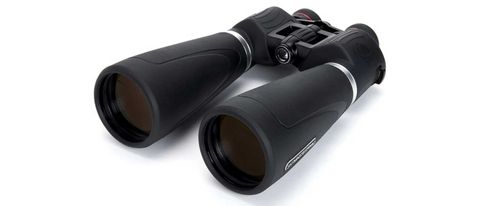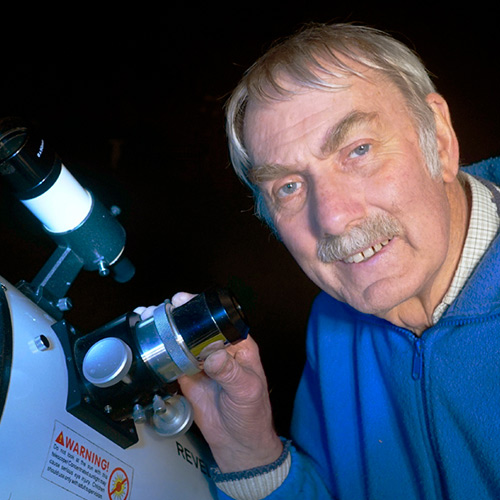Space Verdict
These binoculars give a superb stargazing experience at a reasonable price. There are some views that just can’t be achieved with a telescope, and while they won’t give you close-ups of planets or reveal the most distant galaxies, they make up for it by providing dramatic wide-field views in a good, dark sky.
Pros
- +
Excellent for viewing larger deep-sky objects
- +
Nitrogen-filled prevents internal misting
- +
Waterproof
- +
Robust construction
Cons
- -
Difficult to hold steady
- -
Rubber eyecaps came loose
- -
Tripod adaptor difficult to use
Why you can trust Space.com
Almost every amateur astronomer possesses binoculars, even if they have one of the best telescopes as well. The best binoculars have qualities that telescopes don’t: they are instantly available, easy to use, can be pointed at any object in the sky quickly without the need for motors and give a wide field of view. They allow you to use both eyes for observing, which is far more comfortable than just using one eye. And they are comparatively low-cost.
Standard, everyday binoculars are versatile instruments. The workhorse specification of 10 x 50 (with a magnification of 10 and objective lenses of 50 mm aperture) is an excellent compromise of usefulness for daytime viewing and night use.
Optical design: Porro prism binoculars
Objective diameter: 70 mm
Magnification: 15x
Exit pupil: 4.6 mm
Eye relief: 17 mm
Weight: 1,575 grams
Actual field of view: 4.4 degrees
Apparent field of view: 66 degrees
Close Focus: 15 metres
Construction: Centre focus, nitrogen-filled
Coatings: Fully multi-coated
At night, stars that are too faint to be seen with the naked eye spring into visibility, while the larger nebulae, galaxies and star clusters become recognizable glows. Just scanning along the Milky Way on a good night is something that even experienced observers never tire of.
But of course, they have their limitations. A magnification of 10 is just a bit too low to reveal many of the fainter deep-sky objects, and inevitably one wants to see more. This is where 15 x 70s come in. The increased power is enough to show you many more objects, while the binoculars are still comparatively portable.
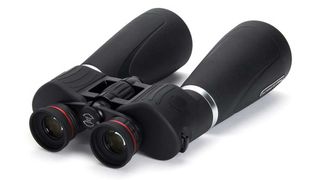
You may think that you can use binoculars instantly, but you do need to set them up for your eyesight. This just takes a few seconds but is essential, because there is a wide variation in the separation and strengths of eyes. First, you need to adjust the separation between the two halves of the binoculars, what’s known as the interpupillary distance, until you can see both circles of light merging into one without any shadowing.
On the Celestron there is a scale of the separation, running from 58 to 72 mm, so make a note of this so that you can adjust them instantly whenever you use them. Next, you need to adjust the focus. Start by focusing on an object with your left eye, using the center focusing wheel, then shift your attention to your right eye. The right eyepiece can be twisted to adjust the focus. Focus it until the same object is sharp and again note the setting. But in this case, the scale of dioptres is not marked so it is a matter of guessing which indentation on the black casing is right for you. I would have expected binoculars in this price range to have the plus or minus dioptre markings picked out in white for easy use.
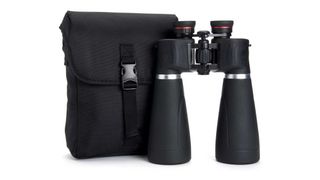
Once you have them adjusted, the view through these binoculars is in a league of its own compared with standard 10 x 50 models. Point them at a bit of sky and stars leap out at you. Where did all those bright stars come from? It can be hard to know which bit of sky you are viewing. And on a good night, the results can be breathtaking. This is real stargazing.
The colors of the stars are also much more obvious. We chose to look at a notably red star, fourth magnitude Mu Cephei. To my eyes, this just looks like another star with the naked eye, but through the 15 x 70s it burns like a glowing coal. You can see why William Herschel referred to it as the Garnet Star.
The Andromeda Galaxy is an easy object through these binoculars, and the increased power compared with 10 x 50s makes its two companion galaxies, M32 and M110, a doddle to spot. The famous galaxy pair of M81 and M82 in Ursa Major were also easily visible, the contrast in their shapes being obvious. We were able to see the larger and brighter galaxies in the Virgo Cluster, such as M87. The darker your skies, the more you will see.
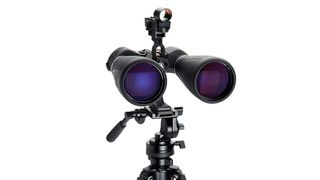
What about planets? A power of 15 is just too low to yield any detail, but Jupiter has an obvious disc, surrounded by its Galilean satellites. Saturn, while not resolved into a planet and rings, is very clearly elongated. Then the ISS came over, and again we were able to see a physical size as it dashed through the field of view. It seemed to be a box shape but had we caught it in a lighter sky rather than as a brilliant glare in a dark sky we believe the H-shape of the solar panel array would have been visible. While there were no bright comets around during the test period, these binoculars would be excellent for viewing a naked-eye comet, with their wide field of view and substantial magnification.
Optically the star images were excellent at the center of the field of view, but the distortion was evident towards the edges, with the stars appearing as streaks. This is not very disturbing, as one’s vision is only sharp at the center anyway, but it means that you would have to move the binoculars to explore a large starfield. To get edge-to-edge sharpness in binoculars of this size you will have to pay a great deal more.
The sight of the full Moon through these binoculars is a show-stopper. Using both eyes rather than just one as with a telescope gives a dramatic feeling of depth, even though there is no actual stereo effect for any object more distant than a few hundred meters. Viewing a bright Moon provides a good opportunity to look for chromatic aberration (false color) introduced by the optics. A trace of false color is inevitable in any instrument that uses conventional achromatic lenses rather than much more expensive apochromatic lenses. In this case, with both eyes viewing centrally in the eyepieces, false color was minimal and had the ‘apple green and plum’ colors which often indicate good correction. Moving the full Moon out of the field of view and looking for unwanted glare showed that baffling of the optics, while not perfect, was good.
As well as the Pro model, Celestron also sells a budget version of these binoculars with almost the same specification, at nearly half the price. So why spend more? With the Pro version, you get a more rugged internal construction, so the binoculars are less likely to go out of alignment and give double vision if subjected to knocks, plus they have fully multi-coated optics. This means that all glass surfaces are coated for better light transmission rather than just some of them. There are various levels of coating, all of which brighten the image, but fully multi-coated optics will give the brightest images for a given aperture.
The Pro model is also waterproof and nitrogen-filled to avoid the risk of internal misting. You might think that as you never observe in the rain you don’t need waterproofing as with binoculars designed for bird-watching or yachting, for example, but bear in mind that the clearest nights are often dew-laden.
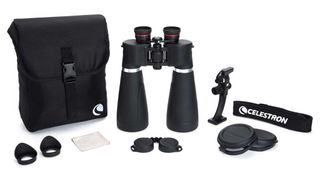
Observers who wear glasses for long or short sight will probably find that the range of adjustment provided means that they don’t need to wear their glasses for observing. But if you have astigmatism, or require an extreme dioptre correction, you will need to fold back the rubber eyecups on the eyepieces so that you can press your glasses against the eyepieces. The binoculars are provided with two types of rubber eyecup – standard low-profile and winged, for excluding extraneous light. But we had trouble with both styles, because I found them both difficult to fit in place and once they were fitted they easily came loose and fell off.
The binoculars have a generous eye relief of 17 mm, which means that you don’t need to get your eyes very close to the eyepieces in order to see the full field of view.
One major drawback with any binoculars larger than the standard sizes is the difficulty of holding them steady. Hand-holding is possible, but many people will find that the weight of them becomes wearisome after a while, although they are considerably lighter than the much more expensive 16 x 70 Fujinon binoculars that we compared them with. Trying to rest them against a wall or whatever helps when the objects you are viewing are low down, but when they are high in the sky this can be difficult.
The Celestron binoculars have a tripod bush on the central pivot, as do many binoculars, and are provided with a sturdy metal bracket accessory to allow you to fit them to a tripod or indeed a monopod, which may be more convenient. This bracket also has a shoe for fitting a standard red-dot finder to help you find objects when using a tripod.
However, when tightening the bracket to the binoculars we found that when it was as tight as needed to prevent wobbling, it was very difficult to undo the bracket from the binoculars afterward. There is a rubber sleeve on the knob intended to give you a better grip, but this just turns uselessly on the inner metal knob. The problem is that the bracket uses a smooth metal washer against the smooth metal surface of the binoculars – no chance of a grip. In two minutes I had made a cardboard washer to replace the metal one, which gave sufficient grip on the binoculars without over-tightening and subsequent removal problems.
These binoculars give a superb stargazing experience at a reasonable price. There are some views that just can’t be achieved with a telescope, and while they won’t give you close-ups of planets or reveal the most distant galaxies, they make up for it by providing dramatic wide-field views in a good, dark sky.
Join our Space Forums to keep talking space on the latest missions, night sky and more! And if you have a news tip, correction or comment, let us know at: community@space.com.
Robin Scagell is a lifelong astronomer. He began his working career with Kodak, back in the days of film, and then spent time observing from the Pic du Midi Observatory in the French Pyrenees. After a career that included making telescopes and editing a photography magazine, he became an author of popular astronomy books including Complete Guide to Stargazing, 101 Things to Spot in the Night Sky and Night Sky Atlas. He has made numerous TV appearances explaining astronomy news stories, and lectures aboard cruise ships. Robin is the Vice President of the Society for Popular Astronomy, and even has an asteroid named after him (24728 Scagell), but neither the asteroid nor Robin poses a threat to civilization as we know it.
